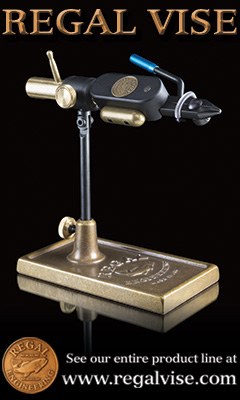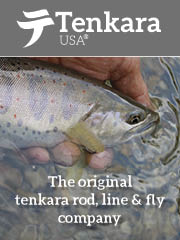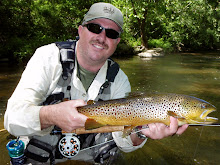23 hours ago
Monday, November 30, 2009
Been busy...
Things have been pretty busy so the posts have slowed down a bit. I've been doing a bit of tying lately but have not taken pictures. Most of the work has been filling up the Czech nymph box so I'll put up some patterns and photos in a few days.
Monday, November 23, 2009
Caddis Larva
I picked up this recipe for a caddis larva pattern from Johan Klingberg. Johan is a fly tier from Sweden who was one of the featured tiers at the Fly Tying Symposium over the weekend. This a great looking pattern that will sink like a rock. It will be an excellent pattern to fish with the Polish\Czech nymphing method. What made this pattern unique was the method in which the dubbing was applied to the hook shank to give that deep segmentation.
Recipe:
Hook: Partridge CZ hook
Weight: Fine square lead wire wrapped in two layers over bottom third of hook (this is what gives the fly the pronounced lower body)
Rib: Olive tying thread
Dubbing: Blue wing olive FlyRite dubbing. FlyRite is a long fibered synthetic dubbing. Long fibers are separated from the bunch, then overlapped and tied in by the tips. Twist the fibers into a rope and wrap on hook. Wraps should not be touching, leave a little gap and fill in with thread ribbing after tying off dubbing.
Legs: Hen feather
I dug out some FlyRite dubbing and started playing around with it. I am going to crank out a couple dozen in different sizes/colors. This should be a good pattern.
Sunday, November 22, 2009
A Weekend of Fly Tying
It was a busy weekend indeed! I spent a full two days at the Inernational Fly Tying Symposium! Checked out some great speakers, enrolled in a Czech Nymph fly tying class and picked up a bunch of materials I have been looking for. Here are a few pictures. I'll get more up later in the week.
Friday, November 20, 2009
Thursday, November 19, 2009
Great weather...great fishing
Hare's Ear Caddis Emerger
Fish this fly any time caddis are on the water. This fly is a great imitation of a caddis pupae.
I typically tie the fly un-weighted and tie it on my leader with a loop knot to give the fly plenty of action. Some times I fish it in the film by itself or behind a dry fly. But more often I fish it as my top fly in a two or three fly nymph rig. Don’t be afraid to impart a little movement into the fly. Swinging or lifting at the end of a drift often brings very aggressive strikes. I have never varied the basic colors of this fly but I will do my best to match the size of the hatching insects.
Recipe:
❖Hook: Tiemco 200R size 12-18
❖Thread: Black Uni 6/0 (8/0 for 16’s & 18’s)
❖Ribbing: Flat gold tinsel or gold wire
❖Dubbing: Hare’s mask or packaged hare’s ear dubbing (I like Hareline Plus #1 Natural Hare’s Ear which is a fur/antron blend)
❖Hackle: Hungarian partridge body feather
❖Collar: Black ostrich herl
Tying Instructions:
Tie in thread near eye of hook and wrap to the rear stopping at a point directly over the barb of the hook.
Tie in you tinsel or wire.
Sparsely dub the tying thread with hare’s ear dubbing and wrap forward, leaving space at the front of the hook for the hackle and collar.
Counter wrap the tinsel or wire forward and tie off. At this time I like to throw in a half hitch or whip finish and brush out the dubbing. You don’t want to do it after finishing the fly because you may damage the hackle and collar.
Tie in a single partridge feather by the tip and make one or two turns at the most (again think sparse, you imitating legs so you don’t need many fibers). Stroke the fibers back as you wrap so they sweep back over the body.
Tie in the ostrich herl. You will need two or three feathers for the larger sizes one will do nicely of the smaller ones. Twist it with your tying thread, wrap forward and tie off.
Build up a neat thread head tie off, apply head cement if you wish and your done
I typically tie the fly un-weighted and tie it on my leader with a loop knot to give the fly plenty of action. Some times I fish it in the film by itself or behind a dry fly. But more often I fish it as my top fly in a two or three fly nymph rig. Don’t be afraid to impart a little movement into the fly. Swinging or lifting at the end of a drift often brings very aggressive strikes. I have never varied the basic colors of this fly but I will do my best to match the size of the hatching insects.
Recipe:
❖Hook: Tiemco 200R size 12-18
❖Thread: Black Uni 6/0 (8/0 for 16’s & 18’s)
❖Ribbing: Flat gold tinsel or gold wire
❖Dubbing: Hare’s mask or packaged hare’s ear dubbing (I like Hareline Plus #1 Natural Hare’s Ear which is a fur/antron blend)
❖Hackle: Hungarian partridge body feather
❖Collar: Black ostrich herl
Tying Instructions:
Tie in thread near eye of hook and wrap to the rear stopping at a point directly over the barb of the hook.
Tie in you tinsel or wire.
Sparsely dub the tying thread with hare’s ear dubbing and wrap forward, leaving space at the front of the hook for the hackle and collar.
Counter wrap the tinsel or wire forward and tie off. At this time I like to throw in a half hitch or whip finish and brush out the dubbing. You don’t want to do it after finishing the fly because you may damage the hackle and collar.
Tie in a single partridge feather by the tip and make one or two turns at the most (again think sparse, you imitating legs so you don’t need many fibers). Stroke the fibers back as you wrap so they sweep back over the body.
Tie in the ostrich herl. You will need two or three feathers for the larger sizes one will do nicely of the smaller ones. Twist it with your tying thread, wrap forward and tie off.
Build up a neat thread head tie off, apply head cement if you wish and your done
Monday, November 16, 2009
More on the new desk...
I have some drawings of the new desk that is on order. It is Stoney Creek's Pennsylvania Masters model with a few custom features like an extra material hutch added to the top, extra deep drawers, secret compartments and electrical outlets and built in surge protector on the worktop. The desk will have 28 drawers total and will be crafted from Cherry stained in a Autumn Wheat color.
Here's a photo of a similar model with a bookcase added over the desk instead of the material hutch.
Should not be long now...
Here's a photo of a similar model with a bookcase added over the desk instead of the material hutch.
Should not be long now...
Sunday, November 15, 2009
Some images from today...
I was able to get out and wet a line with a friend today. Things got fast and furious for a while so there were not many pictures taken but here's a few...
Nice Rainbow with a clear shot of what fooled him. The method was Czech (or Polish) nymphing and this flashback pheasant tail with an oversized faceted tungsten bead was the anchor fly. I originally tied these primarily to get the flies to the bottom, never expecting that oversized bead to be attractive to the fish, but they seem to love it.
Here's the rest of him...
You can't really make it out to well but part of it is tucked neatly behind the jaw.
This fly took one of the biggest fish if the day, a big fat brown. I'm waiting on my buddy to send me the photo I'll put it up when I get it. Flashback Pheasant Tail tied Winona Fly Factory style...
Nice Rainbow with a clear shot of what fooled him. The method was Czech (or Polish) nymphing and this flashback pheasant tail with an oversized faceted tungsten bead was the anchor fly. I originally tied these primarily to get the flies to the bottom, never expecting that oversized bead to be attractive to the fish, but they seem to love it.
Here's the rest of him...
A chunky brown...
This guy and bunch of others took a caddis pupa pattern tied with UV dubbing. I loved the way this pattern looks in the water. Very translucent, very buggy... You can't really make it out to well but part of it is tucked neatly behind the jaw.
This fly took one of the biggest fish if the day, a big fat brown. I'm waiting on my buddy to send me the photo I'll put it up when I get it. Flashback Pheasant Tail tied Winona Fly Factory style...
Saturday, November 14, 2009
Bird and Trout
One of my other passions is fine cutlery. Several weeks ago I recieved this Bird and Trout model from maker Gene Ingram.
I have at least a half a dozen of his knives. And I can say without hesitaion that he does beautiful work. His prices are reasonable to boot. I love the feel of this blade in the hand. It almost makes me want to harvest a trout or two next time I go out...almost...
I have at least a half a dozen of his knives. And I can say without hesitaion that he does beautiful work. His prices are reasonable to boot. I love the feel of this blade in the hand. It almost makes me want to harvest a trout or two next time I go out...almost...
Friday, November 13, 2009
Singlebarbed Sixth Finger Scissor
I have always admired those fly tiers who mastered the art of tying with a pair of scissors in their hands. I call it an art because it is something I have never been able to do. I gave up after I embedded the points of the scissors into my eye brow. I was tying away late one evening and felt a little itch above my right eye...it took about ten minutes to stop the bleeding. I vowed after that to give up on trying to tie with sharp implements in my hands

Yesterday I received a package in the mail that will change all that. The Sixth Finger Scissor. They are an ingenious pair of light weight spring loaded scissors with an oversized ring that comfortably fits over your middle finger. You can find out more about the scissors at Singlebarbed's Blog.
I tied up a dozen flies up last night using the new scissor in hand and I was blown away. After 30 years of tying flies I can finally hold a pair a scissors in my hand while working. I was able to turn out a dozen Czech nymphs without wiping blood from my eyes, which is always a plus! Thanks Singlebarb!

Yesterday I received a package in the mail that will change all that. The Sixth Finger Scissor. They are an ingenious pair of light weight spring loaded scissors with an oversized ring that comfortably fits over your middle finger. You can find out more about the scissors at Singlebarbed's Blog.
I tied up a dozen flies up last night using the new scissor in hand and I was blown away. After 30 years of tying flies I can finally hold a pair a scissors in my hand while working. I was able to turn out a dozen Czech nymphs without wiping blood from my eyes, which is always a plus! Thanks Singlebarb!
Thursday, November 12, 2009
The Desk
The desk... Its an old roll top and it has served me well for many years. I hope to be moving the operation to a custom built fly tying desk that will accommodate two tiers and offer a bit more storage. I placed the order about a month ago with the Stoney Creek Company and delivery should only be a few weeks out. The new set up will allow my son and I to tie side by side.
More to follow...
More to follow...
Wednesday, November 11, 2009
Queen Of The Waters
Over the last few years I have been experimenting with some of the traditional wet fly patterns and methods of fishing them. In recent years there has been a growing interest in these patterns and techiniques. It's hard to imagine that 40-50 years ago this was the most popular way to fish with a fly rod. I have discovered that these methods are just as effective today as it was then.
This fly has become one of my favorites. Fish this fly with any of the standard wet fly presentations. I have found it particularly effective any time there are caddis on the water.
Recipe:
❖ Hook: Mustad 3399 10-14
❖ Thread: Black Uni 6/0
❖ Dubbing: Orange seal fur (seal may be hard to find so feel free to substitute any natural or synthetic orange dubbing) or orange silk depending on whether you want a buggy or trim looking fly. The pictured fly has a dubbed body.
❖ Hackle: Brown hen neck hackle (oversized) tied palmer.
❖ Wing: Natural teal flank feather (or substitute mallard)
Tying Instructions:
Tie in thread near eye of hook and wrap to the rear stopping at a point directly over the barb of the hook.
Tie in your brown hackle by the tip.
Apply dubbing to thread and wrap forward forming a trim body (do not apply too much dubbing)
Palmer brown hackle forward, stroking back the fibers as you wrap forward and tie off.
Tie in a bunch of teal flank fibers over the top of the fly. The length of the wing should be even with the end of the hook.
Build up a neat thread head, whip finish and apply head cement.
On this particular fly several layers of cement were applied starting with thin penetration cement and finishing with a black lacquer cement to give the fly glossy black head. This step is optional and is for aesthetics only (I doubt it matters to the fish).
Tying Tips:
I tie this fly is sizes 10 -14. I have also seen the pattern tied with a tail of brown hackle fibers, the addition of a separate brown hackle collar and even gold wire ribbing. You may wish to add one or all of these options.
Note: the original Ray Bergman pattern called for a silk body and brown hackle tied palmer (no tail, dubbing, collar or ribbing).
Tuesday, November 10, 2009
Red, Yellow, Orange and BROWNS...The Colors of Autumn

Fall is my favorite time of year to be on the water. In my home state the crowds of the spring and summer have either given up on trout fishing or are pursuing other interests such as hunting. Autumn is typically a time of low clear waters and spooky fish. These fish have survived another season of anglers, ospreys, eagles and herons. But the right presentation with the right flies can yield results.
Subscribe to:
Comments (Atom)
































